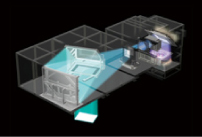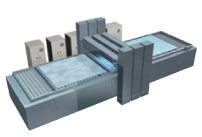USHIO’s photo-alignment technology reduces electric power consumption, improves quality, and lowers costs in LCDs. Thin-panel displays for televisions, for computers, for cell phones the LCDs that are multiplying around us use light in remarkable ways.
USHIO technologies help make the most of light’s ever-amazing properties in LCDs. That includes reducing power consumption and improving image quality. The company is especially strong in UV polarization and in optical exposure. It has built on those strengths and on original advances in backlights, optical design, precision transmission, and photo-alignment in recent breakthroughs in processing for the alignment film used in LCDs. Those breakthroughs are part of the foundation for the next generation of LCDs.
1. Light as Waves
Shaking a rope fixed at one end creates a wave pattern (fig. 1a). We can move the wave pattern through different planes by changing the angle at which we shake the rope (figs. 1b and 1c).
Light waves behave like the waves in the rope. Ordinary light comprises waves vibrating in countless planes. That kind of light is too unmanageable to use in LCDs. So LCD manufacturers design their displays to extract light that vibrates in a single plane—polarized light—and use that light to control the imaging process.

2. To Transmit or Not to Transmit
Manufacturers of LCDs use polarizing filters to create the polarized light. Each LCD contains two of those filters. Only light whose vibrating direction matches the orientation of the polarizing filter can pass through. This is the same principle employed in polarized sunglasses.
Arranging two polarizing filters in the same direction allows light to pass through both filters (fig. 2). Arranging the filters at 90° variance from each other prevents any light from passing all the way through (fig. 3). Using polarization in that manner to transmit or block light is fundamental to LCDs.
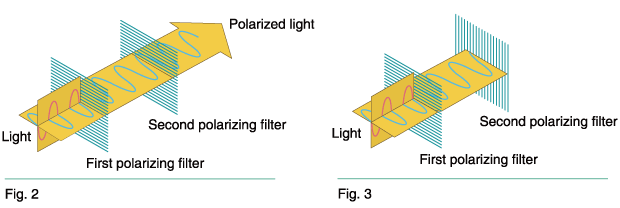
3. In Parallel with Liquid Crystal Molecules
Between the two polarizing filters in an LCD is a layer of liquid crystal. Light tends to proceed in parallel with the directional orientation of the liquid crystal molecules. The light that passes through the first polarizing filter enters the layer of liquid crystal. Changing the orientation of the liquid crystal molecules by applying a voltage causes the light to change direction.
The liquid crystal molecules in a notebook computer screen, with no voltage applied, have a 90% twist. That configuration twists the incoming light 90% and allows it to pass through the second polarizing filter.
Applying a voltage straightens the liquid crystal molecules, and they no longer twist the light. The light cannot pass through the second polarizing filter, and the display darkens. Using color filters can produce the additive primary colors red, green, and blue. Combining those colors can produce full-color display images.
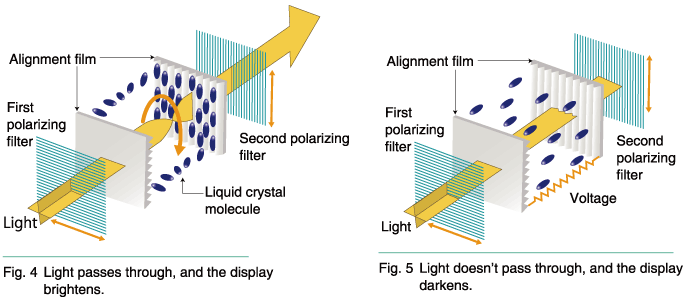
4. The Arrangement of the Molecules
For molecules of liquid crystals to function as a voltage-actuated shutter, they need to have a common directional orientation. The liquid crystal molecules readily assume a crystal-like orientation in response to external stimuli, but the molecules assume a haphazard pattern of directions if left alone. In an LCD, the alignment film fulfills the function of organizing the liquid crystal molecules in the required direction. Preparing that film is a crucial step in LCD manufacturing.
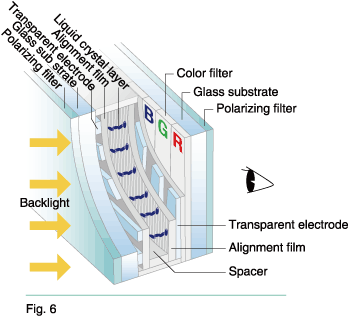
5. Conventional Alignment Processing
Manufacturers of LCD televisions use two kinds of processing to create the film surface used to align the molecules of liquid crystal: rubbing with fine fabric to give the film surface a directional orientation (fig. 7) and forming structural projections atop the surface of the film (fig. 8). Both methods entail problems in regard to yields, cost, environmental impact, and image quality.
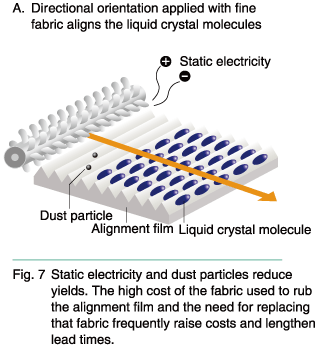
6. A New Approach to Photo-Alignment
Researchers and engineers at USHIO have developed optical alternatives to the conventional mechanical and structural methods of aligning the molecules of liquid crystal. Each of the conventional methods has evolved in the context of a different kind of LCD production sequence. So we have adapted our alternative technology to each kind of sequence. Our technology resolves the drawbacks of both conventional methods. It supports advances in reducing electric power consumption, in improving image quality, and in reducing cost.
We have developed UV curing technology that allows for applying a directional orientation to the alignment film without touching the film. The absence of direct contact eliminates the problems of dust particles and static electricity. Image quality improves, and subsequent cleansing becomes unnecessary, which lowers processing costs.
Similarly, we have developed an optical-exposure alternative to structural members for aligning the molecules of liquid crystal. That lowers processing costs by eliminating the need for structural forming. It also improves optical contrast, speeds the responsiveness of the liquid crystal molecules, and raises the transmission rate for the light from the backlight. Using the backlight output more efficiently allows for a reduction of about 10% in electric power consumption.
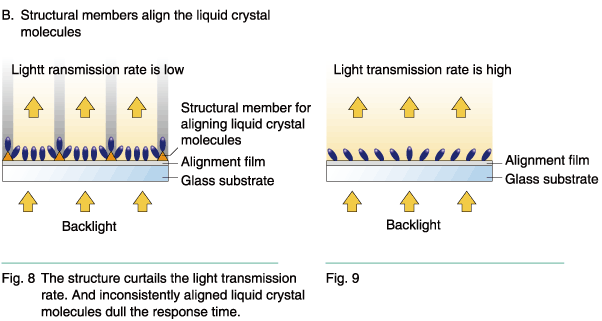
7. Less Electricity, Higher Resolution, Lower Cost
Television manufacturers are moving quickly in R&D to stake out positions in the hugely promising market for high-performance LCD televisions. The chief competitive criteria in that market are electric power consumption, image quality, and cost, and our photo-alignment technology is invaluable in addressing all three of those criteria.
Less than 10% of the light for backlights in present-day LCD televisions reaches the front surface of the displays. Our photo-alignment technology will help raise that transmission rate and will thereby contribute to reductions in electric power consumption, to improvements in image quality, and to reductions in cost. USHIO technology will be more indispensable than ever in the next generation of LCD televisions.
Conceptual Rendering of Photo-Alignment Processing System and of Lamps Used in That System
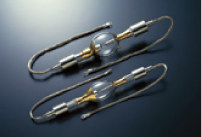
Deep UV lamp
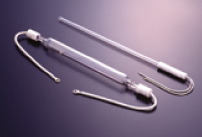
Metal halide lamp

